|
|
|
|||
|
|
||||
|
|
||||
| The (Jet)X Files | ||||
|
|
HOME | SITE MAP | FORUM | CONTACT |
|
||
|
ABOUT | MOTORS | MODELS | ARCHIVE | HISTORY | STORE | FAQ | LINKS
|
|
|
|
|
|
|||||||||||||||||||||||||||||||||||||||||||||||||||||||||||||||||||||
|
The (Jet)X Files 11
(November 2003)
by Roger Simmonds Reprinted from SAM 35 Speaks, November 2003 Duration Matters I've been accused of all but ignoring duration models, to which I plead guilty as charged. In mitigation, these had been well covered in previous SAM (35) Speaks by both John Emmet and Terry Kidd, but this was well before Rapiers arrived. I know little about vintage, or indeed any other, Jetex competition designs, and I arrived too late to witness the first “Golden Age” of Jetex duration contests. I did, however, read avidly of legendary figures like Twomey, Barr, Dowsett, Henderson and even John O’Donnell, (whose wicks I am not worthy to light), battling it out with over 40 other contestants for the SMAE Jetex Trophy and the ICI Challenge Cup. Large numbers of keen competition fliers were attracted to this novel form of propulsion and to, no doubt, the generous prizes offered by ICI, Wilmot Mansour and others. These mighty men quickly mastered the many new skills required, and with designs like Firecrest, Fizzle Quick, Arrow, Stiletto, Snowflake and Vindskreenviper (right) explored and then optimised the design parameters. Following this exciting period there were occasional canards or deltas, for example Lawrence Conover’s ‘Rocket Delta’ that Mike Ingram flew proxy in the 1952 Jetex International Contest (right), but with only small improvements in motor technology and without new contest rules, proven configurations were repeated ad nauseam. Models appear quite homogenous to my untrained eye, and of little interest qua designs. There were of course refinements in trimming and construction techniques, for example Bill Dean in Model Talk (Aeromodeller, Dec 1952), said, “the outstanding trend in Jetex is building lighter and lighter models. Dick Twomey’s 200 entry (Twizzler, below right) weighs 1.1 oz, and Bill Henderson’s 350 entry weighs 1.5 oz”. These and other designs are a challenge even today, and it would be good to see some of them in their element again. John Emmet published a list of “Jetex Contest Designs, 1948-1955” in Jetex Natters, SAM (35) Speaks, Nov. 1991and I’m sure plans for most of these could still be tracked down. Perhaps a contest specifically for vintage designs will stimulate a revival of interest in these models, and Graham Knight is looking into this to gauge the level of interest. 1954, the year of the last “ICI Challenge Trophy” (which by then was attracting far fewer contestants) has been suggested as a possible design cut-off date. As few people have large stocks of Jetex motors or pellets, Jet-X and Rapier motors will definitely be allowed in competition, though not Estes motors. As before, the ratio of burn time to flight time will decide the winner, as motors like the L2 LT would give too large an advantage, especially if scaling down of designs to suit the thrust of motors is allowed. I don’t think any of the Veron and Wilmot Mansour (WM) ‘duration’ kits would be competitive, so perhaps we also need a “sports” category to encourage recreations of these. Veron designs include the Min-o-jet for Jetex 50, Air-o-jet for Jetex 100 (right), and Cirro-jet for Jetex 200, whilst the WM offerings include the Hot Dog for Jetex 50, 200 Contest Model for, unsurprisingly, Jetex 200, and the Dura-jet for Jetex 350. I have seen a number of Keilkraft Cubs and Sky Jets fly with Rapiers, some very well, but I do think the latter design needs reduced dihedral; I wonder if this should be allowed under the rules? My earliest attempts at Jetex ‘duration’ included the Veron Coronette and Verosonic (right). These aren’t dedicated Jetex designs, but they are lovely models and authentically vintage (the Verosonic plan is signed “P.L.S. 1949”, a suprisingly early date). Plans for most of the Veron range are still available from Phil Smith. The Coronette is suitable for L2, but the Verosonic, for Jetex 200, power will need scaling down. The proposed cut-off date would exclude the many nice PAA (Pan American World Airlines) designs. This class was not popular in this country, and of UK ‘duration’ kits of this later period I only know the Keilkraft Star-Jet. This Ian Dowsett design was for the Sebel PAA-Loader, but it is quite suitable for a Rapier L2 HP if built light, though thrust angles etc will need some modification. Kits can still be picked up quite cheaply at swapmeets, and these even include a most welcome sample of Modelspan. Vintage Models |
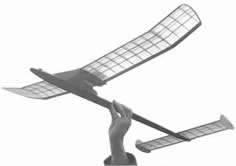
- Bill Henderson
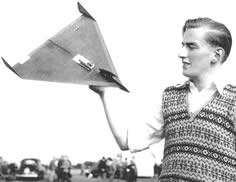
- Mike Ingram

- Aeromodeller, Oct. 1951 (p. 593)

- Model Planes Annual, 1949 (p. 8), 1949 (p. 8)

- Aeromodeller, March 1949
|
|||||||||||||||||||||||||||||||||||||||||||||||||||||||||||||||||||||
|
|
|
|||
|
Both André Bird and Peter Tolhurst have built replicas of Haase’s pre-war Rocket Plane design. This first featured in a 1938 Frank Zaic Yearbook and then later in Laurence Sparey’s 1944 Model Engineer article. André has built the original with elliptical wing tips, whereas Peter went for Sparey’s derivative (right). It really is a most elegant design, and one wonders why Sparey “clipped” the wings. Peter scaled his model to a wing span of 20”, and with the exception of the fuselage, the construction and wood sizes are as specified in the Model Engineer 3-view. The fuselage is made from |
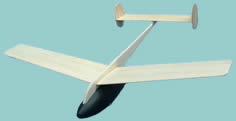
- Peter Tolhurst
|
|||
|
André has also made a copy of Bill Gough’s (1950) twin boom model. Though this was originally for Jetex 100, it is extraordinarily similar to Negri’s 1938 squib-propelled design (see last month’s column). André has brought this interesting design ‘full circle’, so to speak, as his is powered by a Rapier L4. It was flying very impressively at Old Warden earlier this year, seemingly impervious to the blustery conditions. Unfortunately I did not get to speak to André, so I do hope we see him again next year and have a chat. |
||||
|
Nick Peppiat has made a very nice 18” span version of a Howard Boys’ Flaming Ptero (right). This, he says is “quite frantic on L2 power, either performing successive loops or circles at nearly 90° of bank, which could not be controlled even with a large lump of plasticene on the nose”. I suspect the model may be missing its original undercarriage, which might have stabilised the flight pattern a bit. Nick continues, ”exchanging the L2 for the smaller and lower powered L1 effected a transformation. I made a good number of very enjoyable flights with the excess nose weight removed, and would certainly recommend the design”. Nick says that it is (not surprisingly) sensitive to small amounts of differential washout, and several people asked him where the fin was! Whilst on the subject of flying wings, Wilmot Mansour had their own design for Jetex 50 or 100 power (right). This had a very good reputation, and a comparison with Flaming Ptero would be most interesting. Tony Betts has now made this a little bit easier, and has sent me a “pre production” sample of his Physics of Flight kit for the WM Flying Wing, which comes in a very attractive box with its portrait on the top. The contents do not disappoint; the plan has been cleaned up and redrawn to give a span of 27", strip wood for spars is correctly graded, ribs and fuselage sides are CNC cut, and full instructions, tissue, jigs, and even a Rapier motor mount are included. The model is suitable for L2 / L2 HP power, though Tony says it is a wonderful flyer with the new Rapier L2 LT. Now this motor is making quite an impact on the small-scale jet scene, and, with its low thrust (80mN), it might also be suitable for Nick’s Flaming Ptero. The WM Flying Wing is only “the first in a series of vintage kits being reproduced by Physics Of Flight Jet Action and Reaction |

- Nick Peppiat

- Model Aviation 6, Feb. 1950 (p. 2)
|
|||
|
We have seen some most exciting prototypes this year. There have been more than fifteen new scale designs at the various meetings, providing much ‘food for thought’, and we are seeing real progress in the design and trimming of small jet models. Whilst most new models were, like Richard Crossley’s Skyrocket (right) and MiG 1-270, and Pete Smart’s Saunders Roe SR 53 and Skyhawk, variations on an established theme, and none the worse for that, there were several more audacious models, for example an F-117, two He 162s, a Tupolev Badger and XB-51 twin, and, for comic relief, my “turkey of the year”, the Leduc 021. Graham Potter’s sinister and unusual F-117 Stealth Fighter is a clever adaptation of the West Wings rubber power design (for example the elevons are split to allow independent control of pitch and yaw), and looks quite stunning in its all-black finish. It is quite large for a jet propelled model, (24” long, 15.5” for a wing span, weight 67g) and needs all of the thrust of a 250mN L2 HP to get it “in the groove” and complete a sortie. Encouraged by the success of this design, Graham is now building a smaller (80%) version for a standard L2, which will again be put in a trough below the wing. Graham is unimpressed by my suggestion that, ”as this is a ‘stealthy design’, the motor should be hidden in a trough in the fuselage”. |
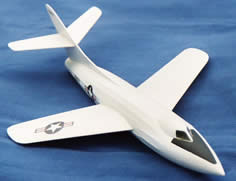
- Roger Simmonds
|
|||
|
The Gloster Javelin was always thought a tricky design, and Graham’s Javelin (right) shows some peculiar flying characteristics. It will be going along nicely, seemingly quite stable and set for a long flight, and then suddenly nose down and spiral into the ground. My first thought was that this was due to the “tailed delta” configuration, as that wretched tailplane could easily get blanked off at certain angles of attack and cause a pitch down, but Pete Smart’s exciting new SR 53, which has a similar planform, appears much more predictable in flight. Both Mike Stuart and Pete Smart have very nice He 162 Salamanders (right) where the motors are enclosed in scale nacelles and exhaust via a foil-lined tube. I was interested to see if the motors lost any power thereby. The definite impression is quite possibly. Mike’s example flew in stable tight circles, neither climbing nor diving, a most curious phenomenon, possibly due to the high thrust line, anhedral wing tips and twin fins. Chris Strachan’s Lockheed U-2 (below right) was flying a little better with a 100 mN L2 and, counter-intuitively, reduced washout. It still will not climb to the stratosphere, so there is room for some more experimentation with this frustrating design, which can fly so well as a glider in larger sizes. Chris’ model is for the U-2A. It may be that the later variant, the U-2R, which has a lengthened body (and a longer moment arm) and larger fin, may make a less intransigent model, despite its higher aspect ratio. Terry Kidd was perhaps deliberately provocative in Jet Reaction, SAM (35) Speaks, Dec 1995. He wrote, “I don’t ever expect to see any of the following in the air: a scale Jetex twin, a scale type with an internally mounted motor, a Jetex flying boat operating off water, a Jetex model with its motor mounted aft of the centre of gravity. I don’t think the modern modellers are up to it”. Now it is true that some established designs like the Keilkraft Swift give even experienced modellers problems, and I have alluded to present difficulties with the Fouga powered sailplane models in a previous column, but eight years on I think we are in a position to refute this outrageous slur on contemporary rocketeers. I suppose Terry, by “in the air”, means, “fly successfully”. If the latter is defined as “a powered flight that includes a gliding phase”, i.e. no hard arrivals with the motor still fizzing, then he will now have to eat at least some of his words. |

- Graham Potter

- Mike Stuart

- Chris Strachan
|
|||
|
Pete Smart’s twin engined Airbus (right) has of course been around for some time, as has Mike Stuart’s Martin XB-51. At Old Warden this year I saw it fly (from a catapult launch) in a very stately fashion with two L1 motors. I believe it now flies for longer, and with more sparkle, when powered by two L2 LTs. Pete’s new Tupolev Tu-16 Badger twin also flies most impressively with these motors, and this was even wonderfully captured on video. Now this must be unique, as normally pointing a camera at any model, especially the more challenging designs, invites disaster! |
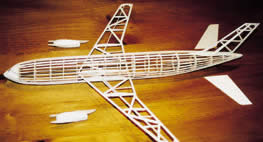
- Pete Smart
|
|||
|
Tony Betts has flown John Darnell’s 1955 Folland Midge with an L2 HP and augmenter tube very successfully, and, after some generous advice from Pete Smart, the Leduc 021 (right) with enclosed L2 made a complete flight at the very hot August SAM Gala. True, it didn’t climb very high, it did porpoise quite a lot, but when it finally hit the deck the ramjet was definitely exhausted, just like the real thing. Less like the real thing was the surprisingly smooth landing the pilot could have walked away from. This model is only a partial success, but it has demonstrated why the ubiquitous trough (which Mike Ingram confirms was Phil Smith’s invention), remains so popular. Not only does mounting a motor internally affect efficiency, it also, according to Peter Cock (who worked at Wilmot Mansour when the augmenter tube was developed), moves the ‘point of thrust’ rearwards, making trimming even more difficult. It also adds weight, and complication. It is very frustrating to prepare a motor, put it inside the model, try to light the fuse by making several stabs at it “down the orifice” and then have a misfire! I’m tempted to say “never again”, but we shall see. Tony Betts' SARO A/1 has two Rapier motors definitely behind the CG, and it appears stable enough in a powered glide, but at Old Warden there wasn’t quite enough power for a climb out. Perhaps two of the new 250 mN L2HP’s will enable a complete flight, though not – and Terry is on to a winner here – a rise off water. I too have a SARO A/1 in dry dock, and was hoping to fly it this year. Unfortunately, most of my summer building time has been spent mending a Bell XS-1 (twice) after it hit hard objects like stooges (these models do land very fast), and recovering a MiG 15 after an onboard fire. Rapier fuses can throw out sparks, especially during a misfire, to which, incidentally, the new types of L2 seem more prone. So beware, and watch where these ejecta land! Because of this, restoration of Mike Mellor’s SARO A/1 is proceeding slowly, and it will not now be finished before next Spring. The fin and tailplane needed rebuilding, so I removed the auto-rudder and added lightness. Modification of the motor mounts for the L2 has pleasingly enabled a more streamlined scale outline, and I have added extra spars to the wing. A lot of time has also been spent making and shaping “lands" to facilitate tissue covering, for example where the wing meets the fuselage, or the engine nacelles blend into the trailing edge. Quite how Bert Judge or Mike Ingram covered these contours without them I do not know. I don’t think modern modellers, (or at least me) are up to it. I have every hope this model will fly well, and to do it justice I need to improve on my usual standard of finishing and decoration. I might even add a pilot. |
 
- Roger Simmonds
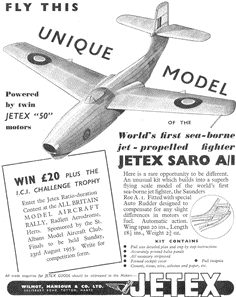
- Aeromodeller, June 1953 (p. 321)
|
|||
|
In conclusion, Terry may well be right in general about modern modellers. Perhaps we need to be pushing more energetically at “the outside of the envelope”, to use Chuck Yeager’s phrase. Who today would contemplate the 1948 Gloster Meteor or Paul del Gatto’s Bomarc (right) with twin Jetex 50s and a Scorpion? Where is a Sud-Ouest Trident for |
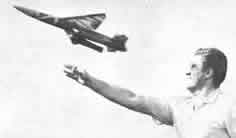
- Model Airplane News, October 1958 (p. 18)
|
|||
|
|
||||
|
|
|
|||
|
|
|
|
|
|
|
|
Acknowledgements - Article: Roger Simmonds - Illustrations: Roger Simmonds, Bill Henderson, Mike Ingram, Peter Tolhurst, Nick Peppiat, Richard Crossley, Graham Potter, Chris Strachan, Pete Smart, MAAC archives via Bill Henderson |
|
|
|
|
ABOUT | MOTORS | MODELS | ARCHIVE | HISTORY | STORE | FAQ | LINKS |
|
|
Terms of Use
|
Queries? Corrections? Additions?
Please
contact us.
|
|